Power electronic handbook
Подождите немного. Документ загружается.

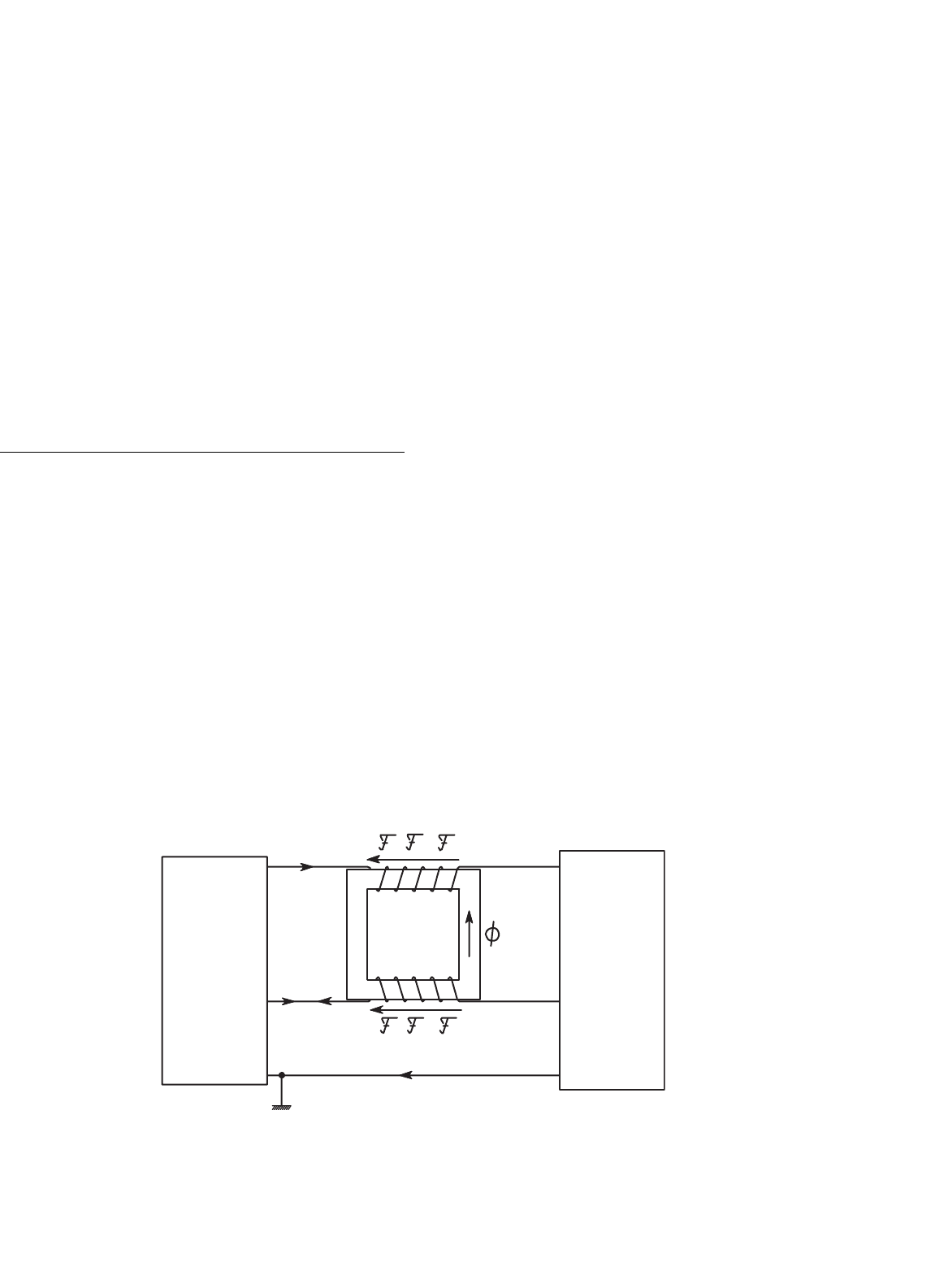
1108 A. M. Trzynadlowski
range is very convenient. The frequency axis can be switched
to a linear or logarithmic scale, while the magnitude is usu-
ally displayed in dBm. True peak and average detectors are
available. Spectrum analyzers are rms calibrated, meaning that
the reading is correct for sinusoidal waveforms only, such as
discrete harmonics of the measured noise. For impulse dis-
turbances, correct peak values are obtained. For broadband
measurements, corrections must be made to convert the true
peak to quasi-peak, and to account for the difference in mea-
surement bandwidths. For help, refer to the manual of a given
spectrum analyzer.
Technical details of EMI measurements for EMC compli-
ance are too vast a topic to be fully covered here. The reader is
referred to such authoritative sources as the already mentioned
CISPR Publication 16 and books [1, 6].
40.4 EMI Filters
EMI generated in power electronic systems usually exceeds
the allowable levels, and it must be reduced. The most com-
mon means of EMI mitigation are low-pass filters, often called
radio-frequency (RF) filters. They are installed on the input
and output sides of power converters. The filters are simple
capacitive (C) or inductive–capacitive (LC) circuits. Resistors
are sometimes added to dampen possible resonances caused
by converters with high switching frequencies.
Choke coils are employed as the inductive components of
the filters. They are usually single-layer solenoid structures
with relatively low coefficients of inductance. In the case of
CM EMI filters, two or three windings are placed on the same
closed iron core. The windings are so arranged that the coil’s
impedance for the CM noise is high, but that for the load
current and DM noise is low. A single-phase CM choke coil
is shown in Fig. 40.7. Letters P, N, and G again denote the
positive, negative, and ground terminals of the mains. It can
CHOKE
COIL
G
MAINS
N
P
EMI
SOURCE
i
L
+ i
dm
+ i
cm1
i
cm2
i
L
+ i
dm
i
cm1
+ i
cm2
cm 12
dm
+
cm1L
+
dm
−+
cm2L
FIGURE 40.7 Single-phase CM choke coil.
be seen that magnetomotive forces F
L
and F
dm
, produced
by the load current i
L
and DM noise current i
dm
in the upper
and lower parts of the coil, cancel each other. As a result,
the magnetic flux
cm12
in the core is generated only by
magnetomotive forces F
cm1
and F
cm2
produced by the CM
noise currents i
cm1
and i
cm2
.
Capacitors employed in EMI filters must have low para-
sitic series inductance, low dielectric and ohmic losses, and
stable capacitance vs frequency characteristics. Paper, met-
alized paper, polystyrene, and ceramic capacitors are widely
used. The so-called multifunction ceramic (MFC) capacitors
can suppress the high-frequency noise and absorb impulse-
type transients. According to their electrical connection mode,
capacitors in power line filters can be classified as X- and Y-
capacitors, the former posing no threat of electrical shock to
personnel, even in the case of a breakdown. Y-capacitors are
typically used for attenuation of the CM noise in power line fil-
ters, but require stricter safety standards and higher reliability
than X-capacitors.
To reduce the parasitic inductance, contributed mostly by
the leads, the so-called feedthrough capacitors have been devel-
oped for use in EMI filters. The wire conducting the load
current passes through the capacitor structure, instead of the
capacitor being connected between it and the ground. This is
illustrated in Figs. 40.8 and 40.9. Figure 40.8a shows the struc-
ture of the feedthrough capacitor and its electric symbol is
shown in Fig. 40.8b. Figure 40.9a shows that in a conventional
capacitor the parasitic inductances, L
p
, of the leads are in series
with the capacitance, C. The total inductance is thus 2L
p
.In
contrast, as seen in Fig. 40.9b, in the feedthrough capacitor,
lead inductances are connected in parallel to each other, so
that the total inductance is L
p
/2.
From the very beginning of modern power electronics,
capacitors have been employed in the so-called snubbers.
In the simplest embodiment, a snubber circuit consists of
a capacitor with a resistor connected in series to dampen
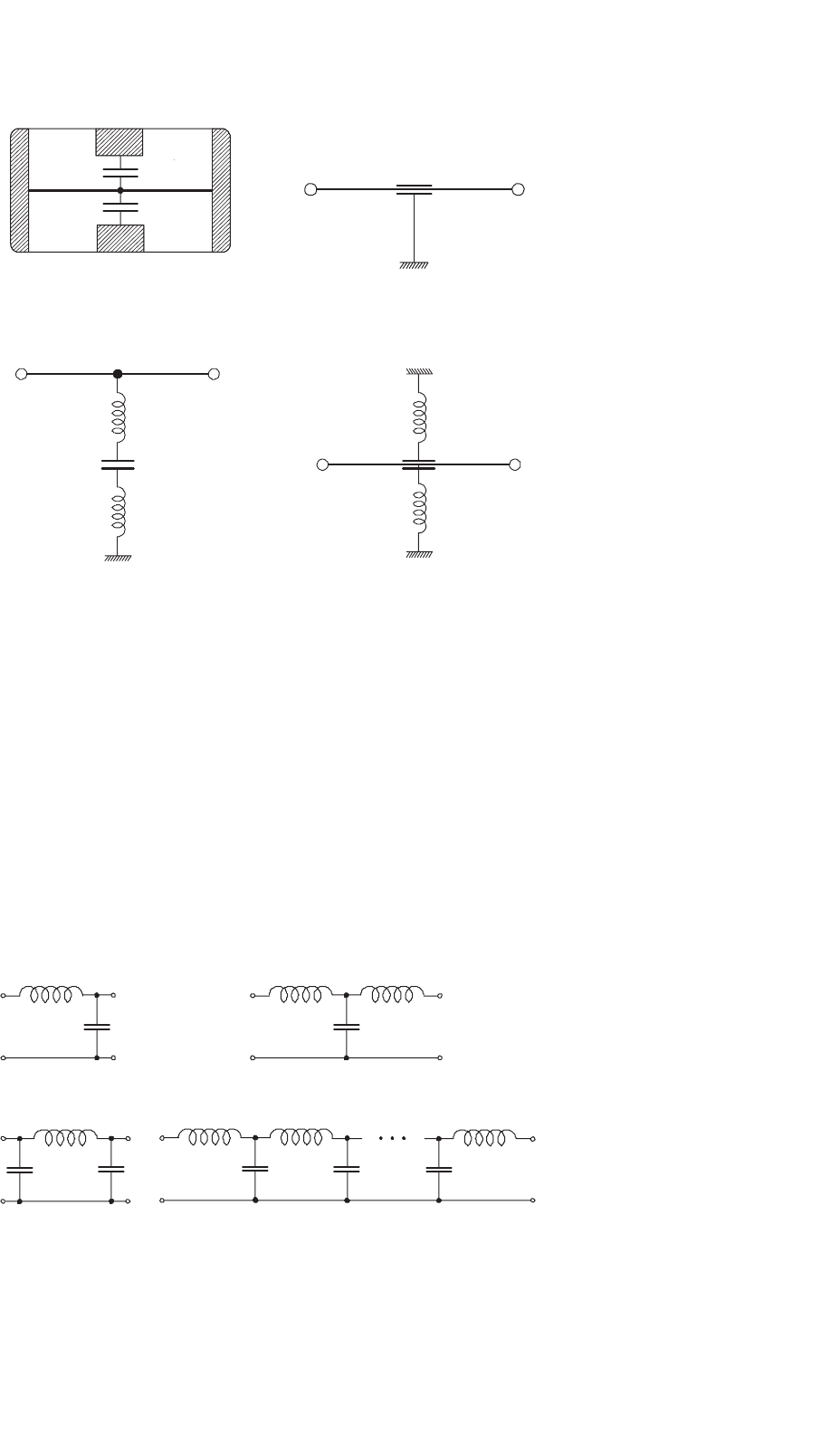
40 EMI Effects of Power Converters 1109
AB
B
G
G
(a)
A
G
(b)
FIGURE 40.8 Feedthrough capacitor: (a) structure and (b) electric symbol.
AB
G
(a)
AB
G
G
(b)
L
p
L
p
C
L
p
L
p
C
FIGURE 40.9 Parasitic inductances of the leads: (a) conventional capacitor and (b) feedthrough capacitor.
possible resonance with parasitic inductances. The snubber
is placed across a semiconductor power switch to improve
the switching conditions and keep the switch within its safe
operating area. Snubbers reduce the EMI, which is particu-
larly strong when the switch turns off, interrupting the load
current.
Noise suppression capacitors, connected to various other
points in a power electronic system, are also widely used,
although they do not mitigate the EMI as effectively as LC
filters with choke coils. Capacitive filters most often appear at
(c) (d)
(a) (b)
FIGURE 40.10 Basic topologies of low-pass LC filters: (a) inverted-gamma (’); (b) pi (); (c) tee (T); and (d) multistage.
the input and output of power electronic converters. They can
be connected between lines or line-to-ground.
Basic topologies of low-pass LC filters are illustrated in
Fig. 40.10. It must be stressed that EMI filters must be placed
in all wires of a power electronic system. Most common con-
figurations are shown in Fig. 40.11 for a two-wire system. The
filters attenuate both the CM and DM conducted EMI. An
extension of the T-type filter on a three-wire system is shown
in Fig. 40.12. Similar extension can be made with respect to
the other topologies of filters.
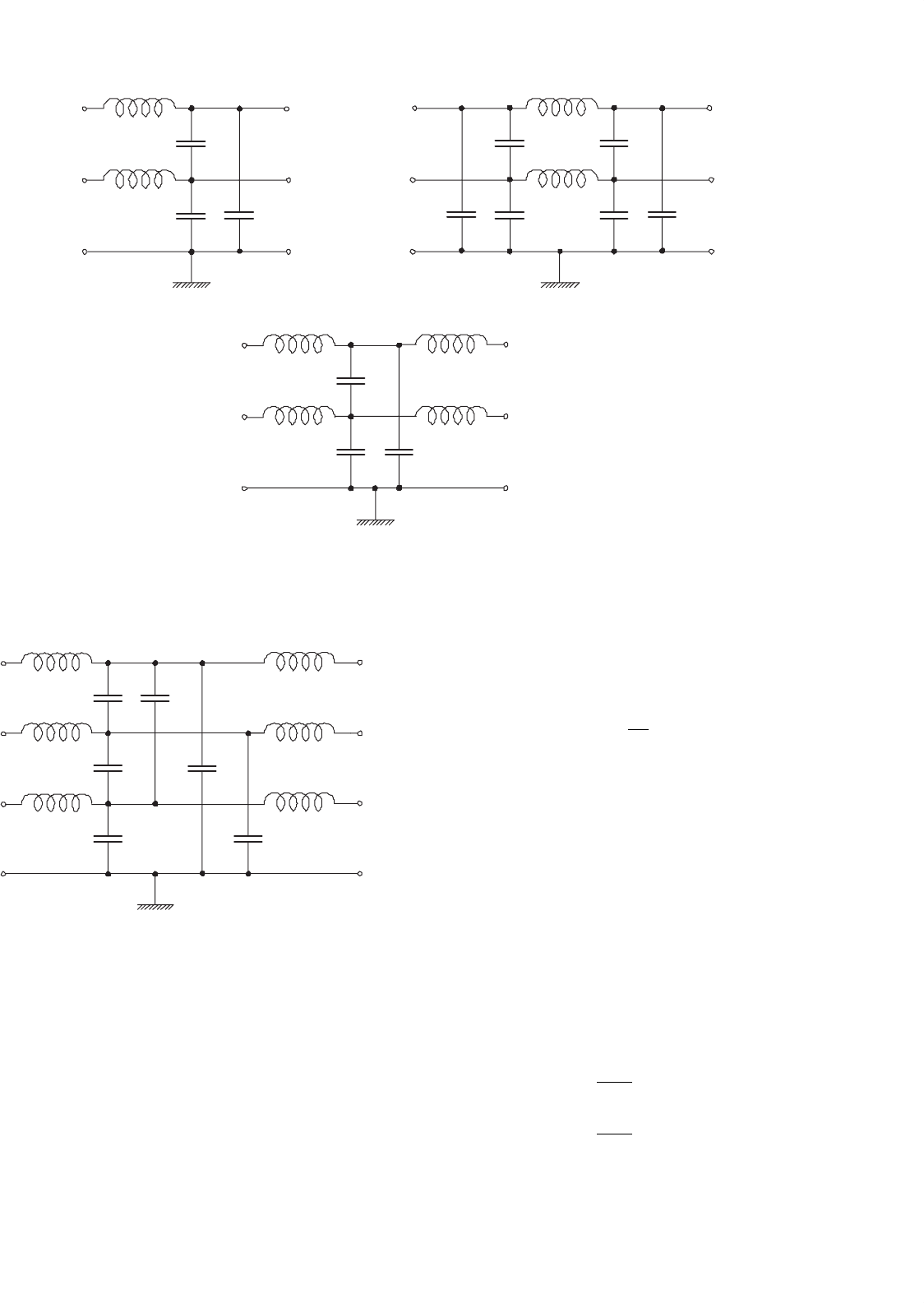
1110 A. M. Trzynadlowski
(a) (b)
(
c
)
A
G
A
G
BB
A
G
B
A
G
B
A
G
B
A
G
B
FIGURE 40.11 EMI filters in a two-wire power electronic system: (a) inverted-gamma (’); (b) pi (); and (c) tee (T).
G
A
B
C
G
A
C
B
FIGURE 40.12 T-type EMI filter in a three-wire power electronic
system.
An example arrangement of the CM and DM EMI filters in
the ac drive system of Fig. 40.1 is shown in Figs. 40.13 and
40.14, respectively (both types of filters are installed in the
actual system, and the two separate circuit diagrams have only
been used for an instructional purpose).
The insertion loss, IL, is the main parameter of EMI filters.
For a given frequency, f, it can be determined by measur-
ing the voltage, V
G
, of a sinusoidal signal generator, and
then connecting the filter to the generator and measuring the
voltage, V
F
, at the filter’s output. Then,
IL = 20 log
V
G
V
F
dB (40.16)
The insertion loss is usually given as an IL(f ) graph with log-
arithmic coordinates. For filter design, the two-port network
theory is employed, using the transmission, A, parameters
expressing the dynamic relations between the input and output
variables of a two-port network. Specifically,
V
1
(s)
I
1
(s)
=
A
11
(s) A
12
(s)
A
21
(s) A
22
(s)
V
2
(s)
I
2
(s)
(40.17)
where V
1
denotes the input (EMI-source side) voltage of the
network, I
1
is the input current, V
2
is the output voltage,
and I
2
is the output current, while s denotes the Laplace
variable (complex frequency). The transmission parameters
are defined as
A
11
(s) =
V
1
(s)
V
2
(s)
|
I
2
= 0 (40.18)
A
12
(s) =
V
1
(s)
I
2
(s)
|
V
2
= 0 (40.19)
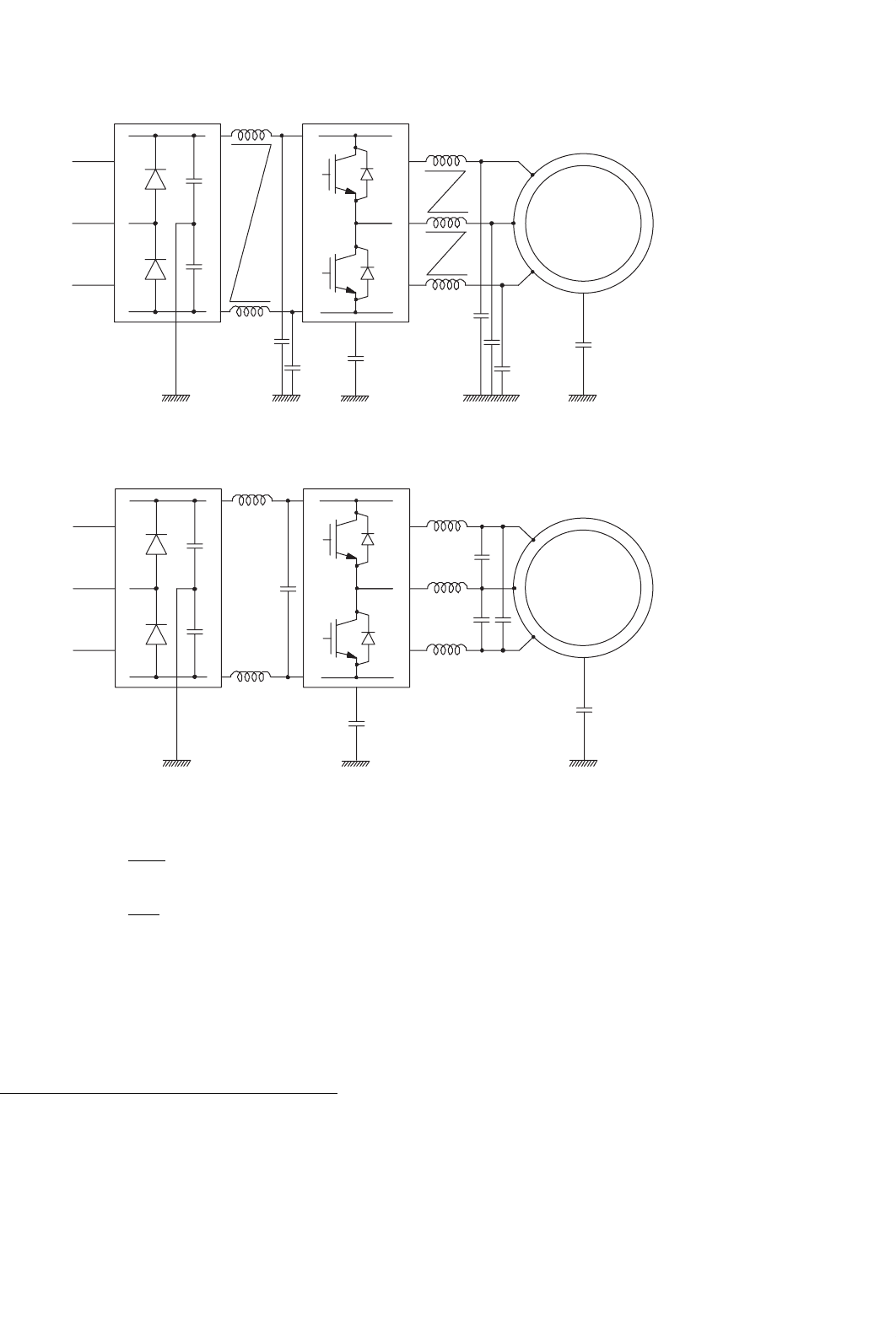
40 EMI Effects of Power Converters 1111
MOTOR
DC SOURCE
INVERTER
C
p
C
p
FIGURE 40.13 Placement of CM EMI filters in the drive system of Fig. 40.1.
MOTOR
DC SOURCE
INVERTER
C
p
C
p
FIGURE 40.14 Placement of DM EMI filters in the drive system of Fig. 40.1.
A
21
(s) =
I
1
(s)
V
2
(s)
|
I
2
= 0 (40.20)
A
22
(s) =
I
1
(s)
I
2
(s)
|
V
2
= 0 (40.21)
Once the transmission parameters for a given filter are deter-
mined using the transient analysis of its circuit, the insertion
loss can be found from the equation
IL(f )
=20log
[A
21
(jω)Z
L
(jω)+A
22
(jω)]Z
S
(jω)+A
11
(jω)Z
L
(jω)+A
11
(jω)
Z
S
(jω)+Z
L
(jω)
(40.22)
where ω = 2πf . Then, the IL(f ) graph can be plotted, as
illustrated in Fig. 40.15 for an actual commercial EMI filter.
The insertion loss is roughly proportional to the total induc-
tance and capacitance (total LC), and square of the frequency.
Because of the cost and size associated with the total LC
value of the filter, an optimal filter is the one with mini-
mum total LC value, which still mitigates the EMI sufficiently
to satisfy the pertaining norm. A difficulty in optimizing the
EMI filter design consists in the mismatched impedance con-
ditions under which the filters operate. From the point of
view of a manufacturer of the filters, the source and load
impedances are simply unknown. However, from the user’s
viewpoint, estimating the source and load impedances allows
for better selection of the filter configuration. Specifically,
for low source and load impedance, the “T” filter is rec-
ommended. The “” configuration is best for high source
and load impedance, while for low source and high load
impedance, the “” (LC) filter is preferred. Finally, for high
source and low load impedance, the “” (CL) topology is
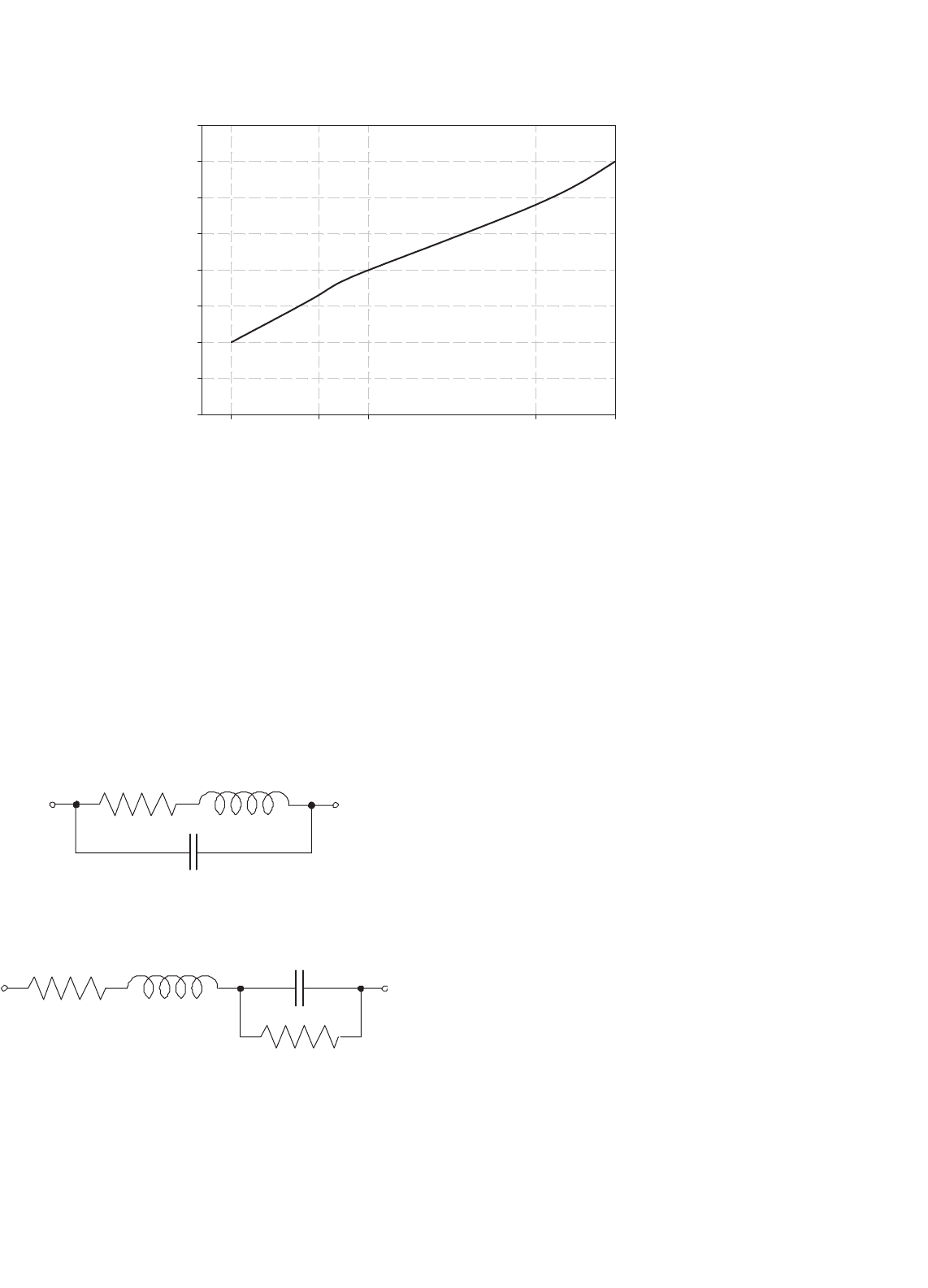
1112 A. M. Trzynadlowski
f (MHz)
0.15 0.5 10 30
IL (dB)
0
10
20
30
40
50
60
70
80
1
FIGURE 40.15 An example insertion loss vs frequency graph for an EMI filter.
favored. If possible, multiple-stage filter topologies should be
employed.
Practical design of EMI filters is complicated by the fact that
there are no ideal inductors and capacitors. Considering the
equivalent electric circuit of an inductor in Fig. 40.16a and
that of a capacitor in Fig. 40.16b, it can be seen that at very
high frequencies, the impedance of the parasitic components,
marked by the subscript “p,” may dominate that of the main
component. Thus, the reactance of the parasitic capacitance,
C
p
, of the inductor can make the overall impedance to decrease
(b)
(a)
L
C
p
R
p
C
L
p
R
p1
R
p2
FIGURE 40.16 High-frequency equivalent circuits of: (a) capacitor and
(b) inductor.
with the frequency, and the reactance of the parasitic induc-
tance, L
p
, of the capacitor can make the overall impedance
of the capacitor to increase with the frequency. That is why
manufacturers of EMI filters and their components go to such
lengths to minimize the parasitics.
In the common case of power electronic converters fed from
the grid, the so-called power line filter is installed between the
grid and converter. It protects the converter and its load from
external disturbances and, vice versa, screens out the grid from
EMI generated in the converter. Voltage impulses originated
within the grid are particularly hazardous for the converter,
and varistors are used in the filter to attenuate the impulses. An
example of commercial power line filter is shown in Fig. 40.17.
In the drive system in Fig. 40.1, the filter would be connected
to the three-phase input terminals of the dc source (rectifier).
Numerous companies offer a variety of power line and EMI
filters with various voltage and current ratings. Thus, designers
of power converters and converter-fed systems have a choice
of quality products, without the need for designing their own
filters. Useful details of the process of EMI filters design can
be found in [6–8].
Active EMI filters, although very effective, are less common
than the passive filters described because of their increased
complexity and cost. They are based on the feedback principle,
generating currents that neutralize the noise currents. In
dc-to-dc converters, they are also used to limit inrush cur-
rents, for example during the so-called hot swapping when a
faulty electronic board is replaced without interrupting opera-
tion of the system. In certain three-phase systems with power
converters such as ac drives, the CM voltage noise, apart from
producing external interference, causes internal problems,
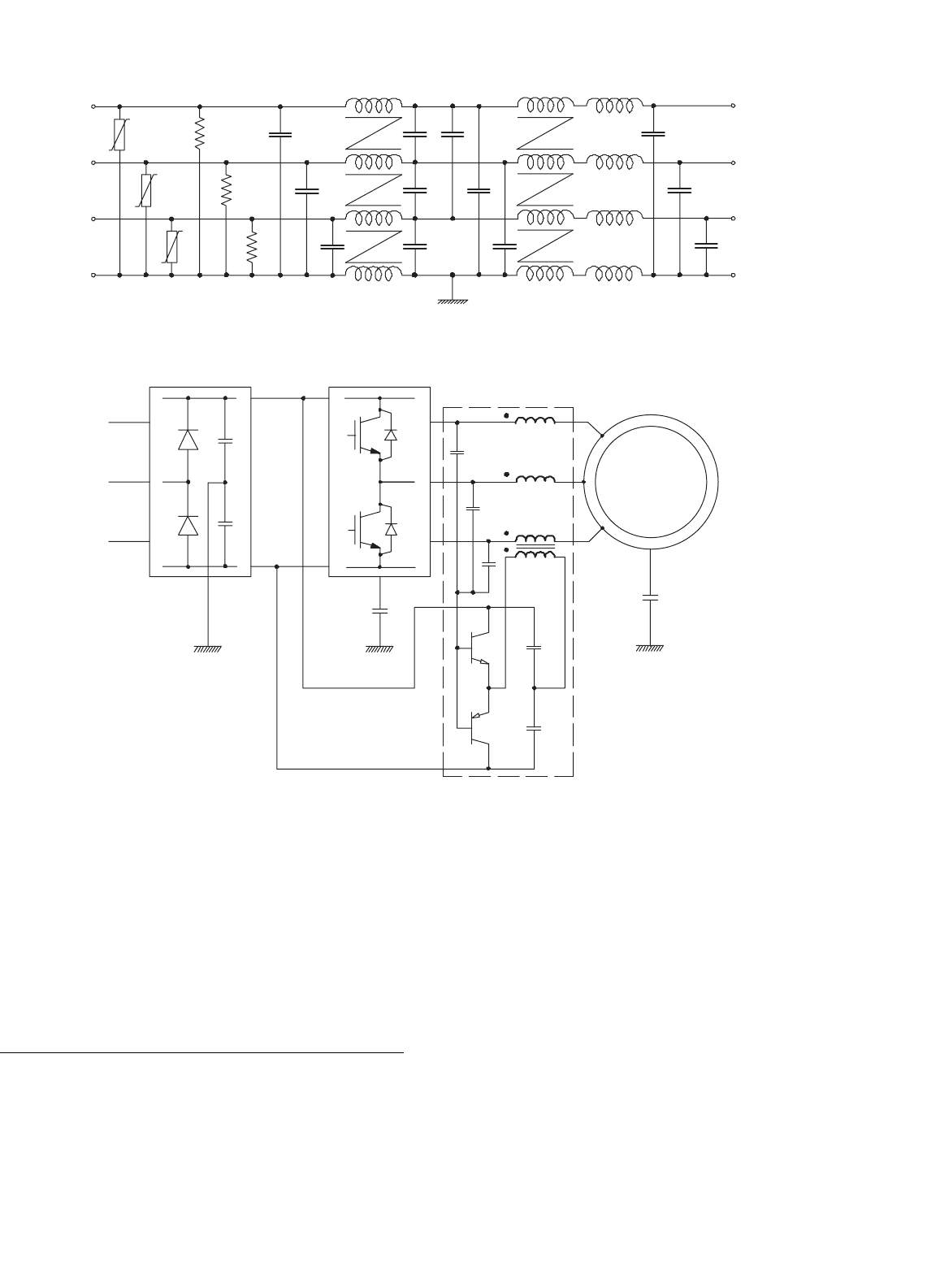
40 EMI Effects of Power Converters 1113
A
B
C
G
A
B
C
G
FIGURE 40.17 Power line filter.
DC SOURCE
INVERTER
C
p
MOTOR
C
p
COMMON-MODE
VOLTAGE CANCELLER
FIGURE 40.18 Common-mode voltage canceller.
e.g. accelerated wear of bearings. The so-called CM voltage
cancellers are one of the means to mitigate those problems.
Such a voltage canceller in the drive system of Fig. 40.1 is
shown in Fig. 40.18.
40.5 Random Pulse Width Modulation
Suppression of the low-frequency noise, originating from the
PWM operating mode of most power converters, is partic-
ularly difficult. As already pointed out in Section 40.1, the
noise, mostly harmonics of the voltages and currents, appears
in the frequency spectra as harmonic clusters around mul-
tiples of the switching frequency, f
sw
. As seen in Fig. 40.1,
the highest magnitudes of the harmonics appear at the lower
end of the frequency range, while, as shown in Fig. 40.15, the
insertion loss of EMI filters progressively increases with the
frequency. Thus, at low frequencies, effectiveness of the filters
decreases. Increasing the total LC value helps, but it results
in corresponding increase of the cost and bulk of the filters.
Therefore, mitigation of the harmonics by means of special
PWM strategies is the best solution for filter minimization.
Most of the commercial PWM power converters are char-
acterized by a fixed switching frequency, f
sw
, defined here as a
reciprocal of the switching period, T
sw
. The switching period
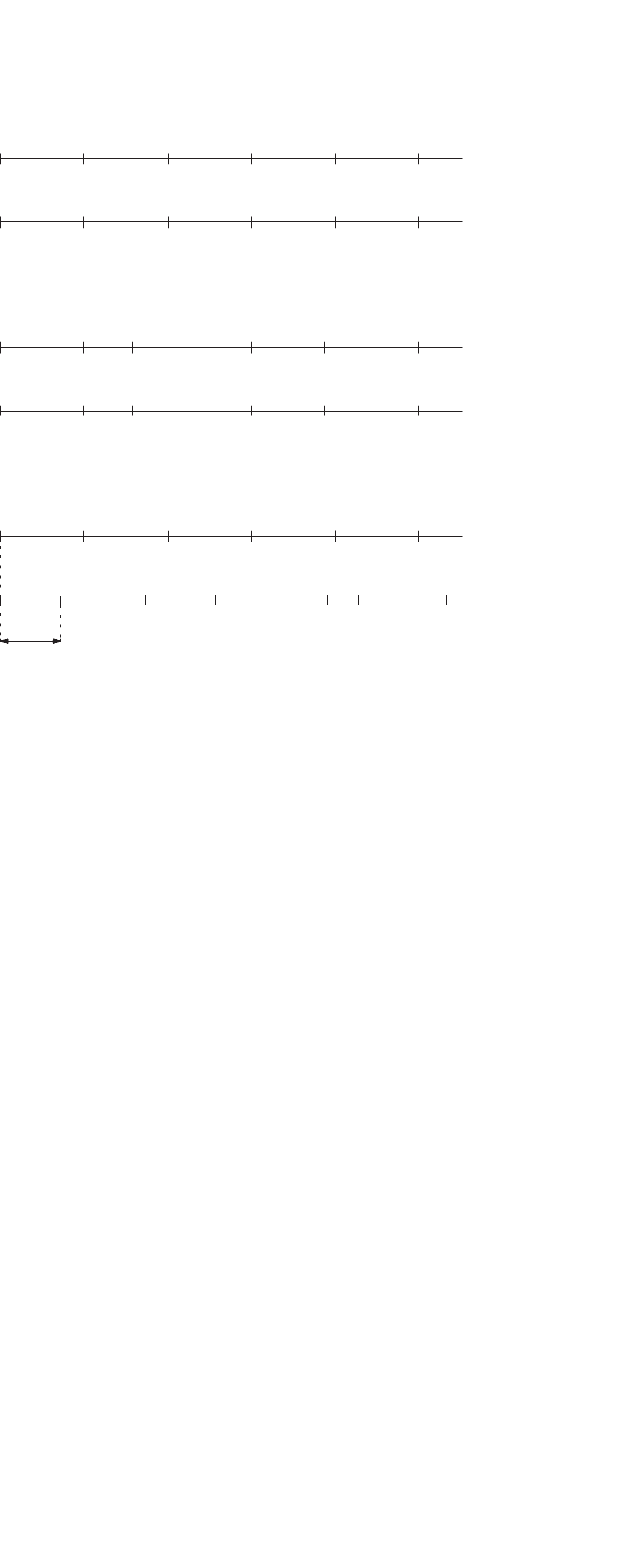
1114 A. M. Trzynadlowski
constitutes the length of a switching interval, which houses
pulses of switching variables of the converter, one pulse per
variable. Duty ratio of a given pulse varies from 0 to 1, that is,
the width of the pulse is in the range of 0−T
sw
. It has been
demonstrated in several publications that if individual switch-
ing periods are randomly varied, then the discrete harmonic
power (watts) of spectra of the voltages and currents of the
converter is transferred to continuous power spectral density
(watts/hertz) [9]. This strategy of random pulse width mod-
ulation (RPWM) results in significant mitigation of both the
acoustic and electromagnetic noise associated with the current
harmonics [10, 11]. Accumulated experience and theoretical
considerations show that varying T
sw
from 50 to 150% of the
average switching period, T
sw,ave
, is sufficient. Thus, the nth
switching period is determined as
T
sw,n
= (r
n
+0.5)T
sw,ave
(40.23)
where r
n
is a uniform-probability random number in the 0–1
range.
For convenience, in practical digital modulators for PWM
converters, the switching cycles coincide with the sampling
cycles of the modulator, that is, f
sw
= f
smp
, where f
smp
denotes
the sampling frequency (not to be confused with the much
higher clock frequency). Consequently, the varying switching
rate is associated with identically varying sampling rate. When
a single digital system performs more tasks than just PWM, the
random sampling rate is a distinct disadvantage. For instance,
in a control system, the sampling rate defines the control band-
width and it is selected at a specific trade-off level. Therefore,
an RPWM technique with a fixed sampling rate but variable
switching frequency is more practical. Figure 40.19 illustrates:
(a) the most common, non-random PWM technique with
fixed-period and coinciding sampling and switching cycles,
(b) RPWM with randomly varied and coinciding sampling and
switching cycles, and (c) RPWM with fixed sampling periods
and randomly varied switching periods, subsequently referred
to as variable-delay RPWM (VD RPWM).
As seen in Fig. 40.19c, the switching cycles in the VD RPWM
method are delayed with respect to the corresponding sam-
pling cycles by a randomly varied time delay, d. The value of
d for the nth switching cycle is calculated as
d
n
= r
n
T
smp
(40.24)
where T
smp
= 1/f
smp
denotes the sampling period. When in
two consecutive switching cycles, the k th and k+1th, r
k
is
close to 1 and r
k+1
is close to 0, the second, k +1th, switching
cycle may be too short, that is, its length, T
sw,k+1
, may be
lower than the minimum allowable length, T
sw,min
. Therefore,
in case of such occurrence,T
sw,k+1
is set to T
sw,min
, or another
value of r
k
is selected. As a result, the switching periods vary
from T
min
to 2T
smp
. The average switching period, T
sw,ave
,
equals the sampling period, T
smp
.
n
n +1
n
n+1
n
n+1n+2n+3n+4
n
n+1n+2
n+2
n+2
n+2
n+3
n+3
n+3
n+3
n+4
n+4
n+4
n
n +1n+4
n
n +2n +1n+3n+4
n−1
. . .
. . .
. . .
. . .
. . .
. . .
SAMPLING CYCLES
SWITCHING CYCLES
SAMPLING CYCLES
SWITCHING CYCLES
SAMPLING CYCLES
SWITCHING CYCLES
(b)
(a)
d
n
(c)
t
t
t
t
t
t
FIGURE 40.19 Illustration of PWM techniques: (a) fixed-period and
coinciding sampling and switching cycles; (b) randomly varied and coin-
ciding sampling and switching cycles; and (c) fixed-period sampling cycles
and variable-period switching cycles (VD RPWM).
Any PWM strategy based on the concept of switching cycles
can be employed within the RPWM method. For instance, the
popular space-vector modulation can be used in three-phase
voltage-source inverters. As long as the average switching
period is sufficiently short, the quality of output current is
similar to that in a converter with a fixed switching frequency
having the same period. An example spectrum of the out-
put current of a voltage-source inverter controlled using the
VD RPWM is shown in Fig. 40.20. It is the same converter
whose current spectrum, with fixed-period PWM, was shown
in Fig. 40.3. The noise suppression by some 10 dBµA is eas-
ily observable. A spectrum corresponding to that in Fig. 40.4
is shown in Fig. 40.21. Here, the EMI mitigation, by about
20 dBµA, is even stronger.
Although RPWM is not a perfect tool for EMI mitiga-
tion, it effectively eliminates high harmonics of the input
and output currents and output voltages in PWM power
converters. The EMI filters are usually still needed for the
suppression of transients, impulses, and high-frequency noise.
However, their total LC value can be greatly reduced. The
RPWM technique with random switching and sampling peri-
ods is a little more effective than the VD RPWM because
of the somewhat bigger freedom of randomization, and it is
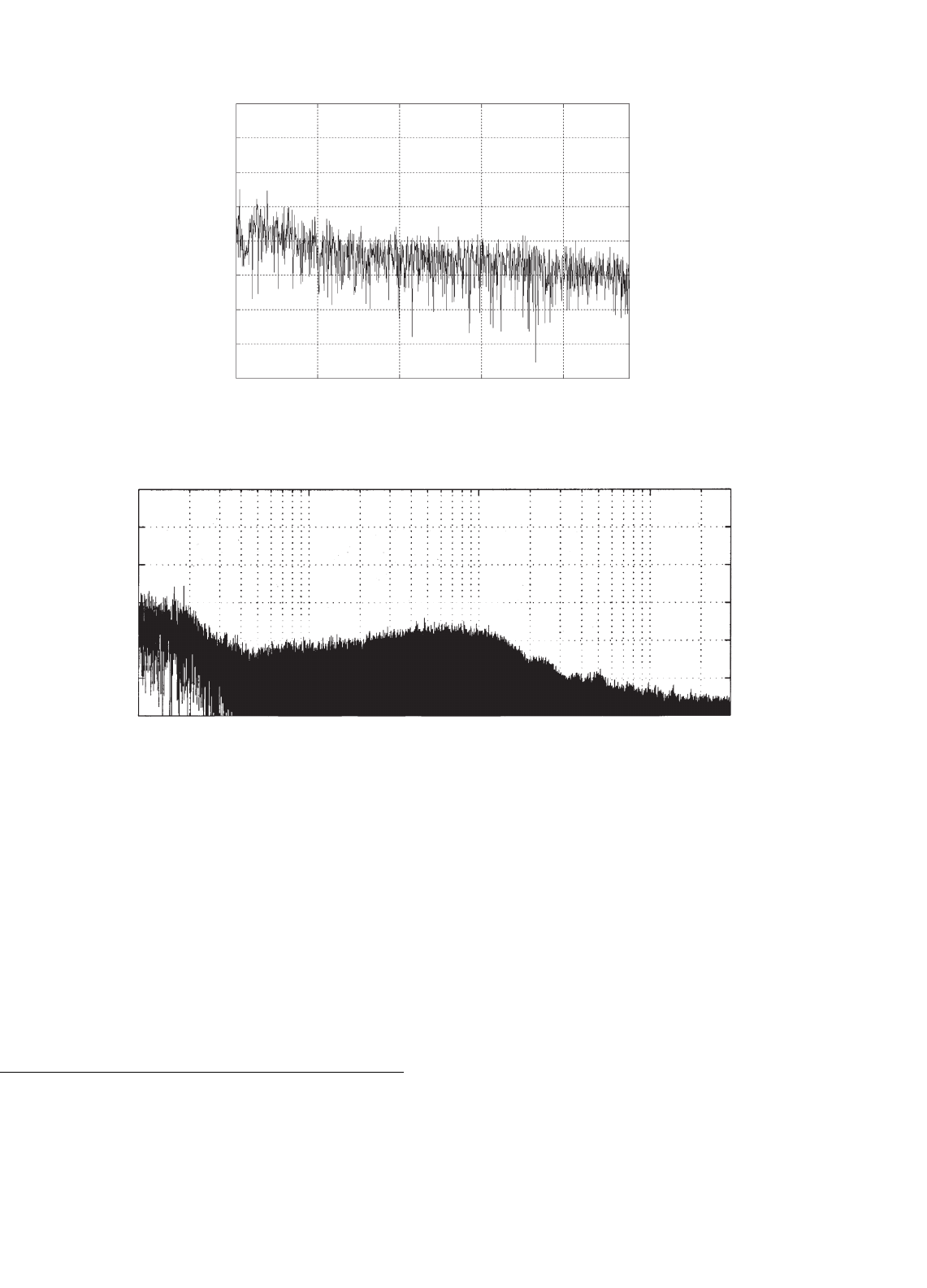
40 EMI Effects of Power Converters 1115
Frequency (Hz)
x 10
4
21.50.5
60
70
Armature Current Noise (uAdB)
80
90
100
110
120
130
140
11
FIGURE 40.20 Frequency spectrum of output current of a voltage-source inverter with VD RPWM.
Frequency (MHz)
70
80
90
Current Noise (uAdB)
100
110
120
130
10
−2
10
−1
10
0
10
1
FIGURE 40.21 Wide-range frequency spectrum of inverter current with VD RPWM.
recommended for converters whose pulse width modulator
operates independently of the rest of the system.
It is worth mentioning that PWM techniques have been
developed that reduce the CM noise in three-phase inverters
by elimination (or significant reduction of use) of the so-called
zero states, in which all the three-phase terminals are clamped
by the inverter switches to one of the dc buses. Other solu-
tions involve addition of a fourth leg to the inverter, or use of
multilevel inverters.
40.6 Other Means of Noise Suppression
In addition to filters and PWM methods, means of mitigation
of EMI effects in systems with power converters include
grounding, shielding, and reduction of electromagnetic
coupling. When skillfully used, they can significantly reduce
the EMI and circuit susceptibility at a low extra cost.
Effects of grounding on the EMI must be considered in the
context of the whole system employing power electronic con-
verters. Grounding of electric equipment has historically been
based on the requirements of safe and reliable power distri-
bution, maximum protection against overvoltages (including
lightning strikes and electrostatic buildup), and safe-touch
conditions for personnel during ground faults. The so-called
safety ground (green wire in the USA) protects personnel and
equipment by conducting fault current, operating a circuit
breaker or fuse, and limiting the voltage to ground during
faults. This type of grounding can be termed low-frequency
grounding. The earth ground is made using buried rods, plates,
or grids. Note that the ground wiring for lightning protection
must be isolated from other grounding conductors, and the

1116 A. M. Trzynadlowski
1
2
C
12
1
2
M
12
(a) (b)
v
n
v
n
FIGURE 40.22 Electromagnetic coupling: (a) capacitive and (b) inductive.
lightning current may not pass through any circuit breaker
or fuse. Considering the drive system in Fig. 40.1 and assum-
ing the “wye” connection of the secondary windings of the
supplying transformer, the neutral of the transformer can be
ungrounded, directly grounded, or connected to the ground
through a resistor. Each of these arrangements has advan-
tages and disadvantages, but the resistance-grounded system
has gained the greatest popularity, because the line-to-ground
faults do not cause immediate shutdown of the system. Proper
selection of the grounding resistance allows sufficient limita-
tion of the ground fault currents and the voltage-to-ground to
avoid equipment failures.
The high-frequency grounding, which should be consid-
ered separately from the low-frequency scheme, has a strong
impact on the CM EMI. The general rule for proper high-
frequency grounding design is to understand the CM noise
path and to reroute the noise away from the sensitive elec-
tronics. A single-point grounding scheme is theoretically the
best, although the existence of many stray system-to-ground
capacitances makes it practically a multipoint grounding above
certain frequencies. Physical capacitors are often used to aug-
ment the stray capacitances, for example, between the chassis
and the grounding wire, to reduce the CM noise voltage. High-
power parts of a system should be connected the closest to
the single-point ground, with the most sensitive circuits the
furthest from it.
Most practical systems with power converters include cables,
e.g. those connecting the inverter to the motor in the drive in
Fig. 40.1. The cables act as antennas for the radiated EMI and
are the receptors in the electromagnetic coupling. Shielding
the cables significantly reduces those unwanted phenomena.
Such types of cables as the aluminum-armor or braided-shield
ones offer very good protection from EMI. In particular, they
prevent interference with sensitive equipment by providing an
isolated and predictable metallic path for the CM noise. The
shield is usually bonded with the ground wire at both ends
of the cable. For industrial installations, such as drive systems
in a factory, use of grounded steel conduits to carry cables
is a convenient and effective solution. Shielding can also be
applied to other than cables parts of the electronic circuitry,
such as circuit enclosures.
As illustrated in Fig. 40.22, the electromagnetic noise cou-
pling can be capacitive (electric field) or inductive (magnetic
field). The noise source-voltage is denoted by v
n
, and the stray
capacitance, C
12
, and mutual inductance, M
12
link wires 1 and
2 transmitting noise from the source. The coupling capaci-
tances and inductances should therefore be minimized. The
simplest, but not always practical, approach is to increase
the distances between noise sources and receivers. Shielding
is a good protection from electromagnetic noise coupling, and
the unshielded leads extending beyond the shield should be
possibly short.
Electromagnetic noise coupling can also be minimized by
proper circuit geometry. The potential noise source should
not be placed in parallel to the potential noise receiver. Per-
pendicular placement is best. Twisting two interconnecting
wires helps as well, because currents in individual wires flow
in opposite directions, producing magnetic fields that cancel
each other.
EMI reduction techniques should also be considered at the
printed circuit board (PCB) level. Proper grounding, power
distribution, and interconnection techniques, depending on
whether the PCB contains analog or digital circuitry, improve
immunity to both the internal and external noise sources.
This highly specialized topic extends the tutorial scope of this
publication.
A thorough compendium of various means of EMI mitiga-
tion in inverter-fed ac drive systems can be found in [12]. It
should be stressed that EMI suppression techniques should
be considered in early stages of the design. Otherwise, the
designed system is very likely to have serious and expensive
to solve noise problems.
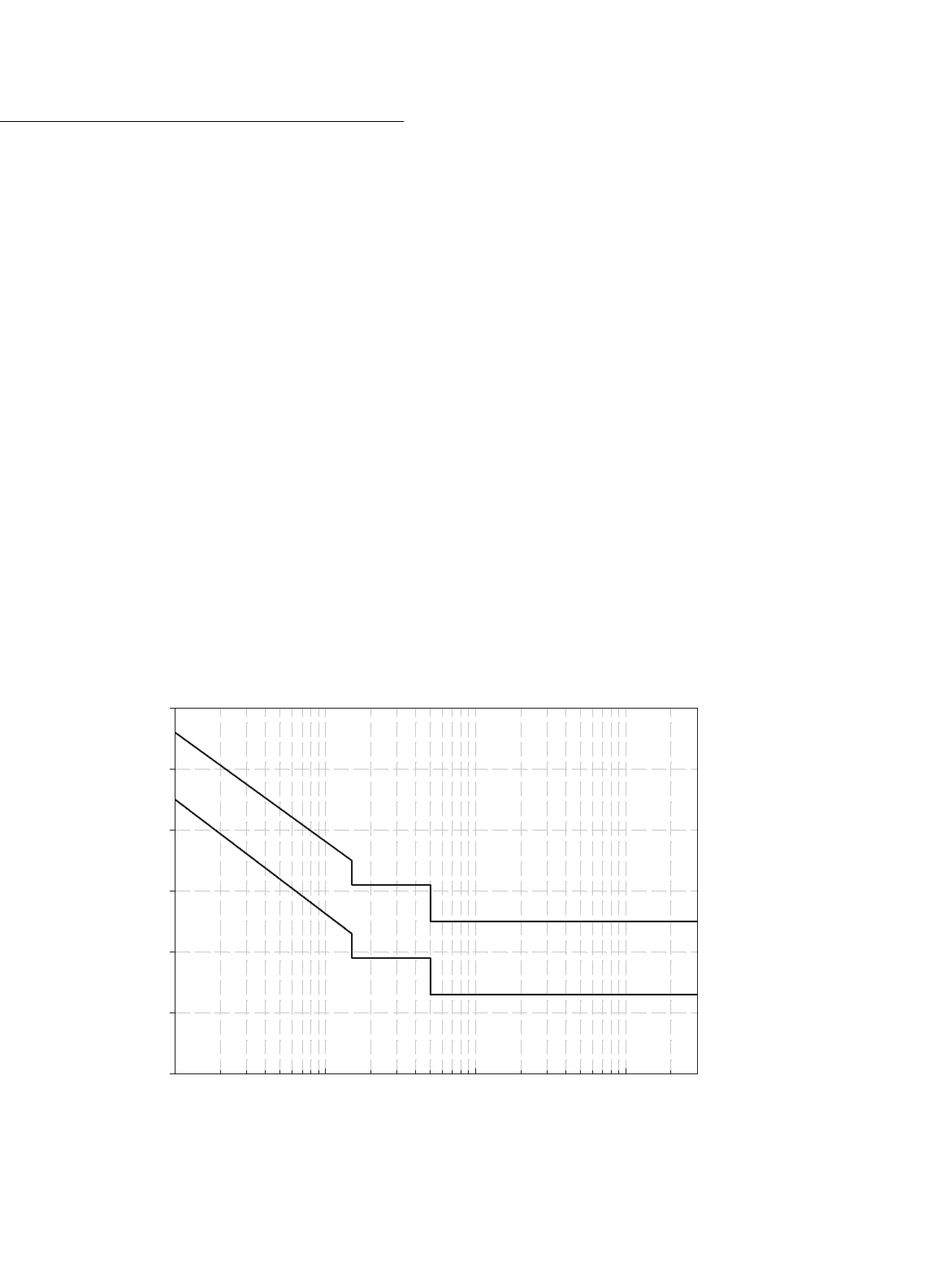
40 EMI Effects of Power Converters 1117
40.7 EMC Standards
The number of institutions involved in regulations and rec-
ommendations that concern EMI is quite large, and to an
average person the issue of EMC standards can be some-
what confusing. EMC is defined as the ability of equipment
to function satisfactorily in its electromagnetic environment
without introducing intolerable disturbances to anything in
that environment. EMC requirements entail two major items:
emissions and susceptibility, or its opposition, the immu-
nity. Electromagnetic disturbance is any phenomenon that
may degrade the performance of a device or system, or
adversely affect the living and inert matter. The term “EMI”
pertains to that performance degradation. It is worth mention-
ing that in the colloquial engineering language, EMI is often
meant as emissions and EMC as immunity, which is inexact.
In the important U.S. military standard MIL-STD 461, the
emissions and immunity requirements are referred to as con-
ducted/radiated emissions (CE/RE) and conducted/radiated
susceptibility (CS/RS).
In the USA, it is the Federal Communication Commission
(FCC) that sets the general EMC requirements (medical prod-
ucts are regulated by the Food and Drug Administration).
The FCC Rules and Regulations, Title 47, Part 15, Subpart
B concerns “any unintentional radiator (device or system) that
generates and uses timing pulses at a rate in excess of 9000 pulses
(cycles) per second and uses digital techniques.” Clearly, that
mandatory requirement applies to almost every product that
MHz
0.01 0.1 1 10
dBµV
30
40
50
60
70
80
90
FIGURE 40.23 FCC conducted emissions limits. Upper trace: Class A and lower trace: Class B.
employs a microprocessor. It is illegal to sell or advertise for
sale any product regulated under Part 15, Sub-part B until its
emissions have been measured and found to be in compliance.
Products regulated by Part 15, Subpart B are divided in two
classes. Class A devices are those marketed for use in com-
mercial applications, while the domestic applications belong
in Class B. As illustrated in Fig. 40.23, Class B limits are more
stringent than those for Class A products, and the Class B
administrative certification process is more rigorous than the
Class A verification process. The American National Standards
Institute (ANSI) standard C63.4 defines the required emis-
sion test procedures. However, there are no FCC regulations
pertaining to product immunity to electromagnetic fields.
EMC requirements for products used by the U.S. military
are listed in the already mentioned MIL-STD-461. This stan-
dard is applicable to a wide range of systems, from power tools
to computer workstations. Unlike the FCC Regulations, MIL-
STD-461 specifies limits for both the emissions and immunity.
The ANSI and Institute of Electrical and Electronics Engineers
(IEEE) also publish EMC standards, as do, for internal use,
such private organizations as Society of Automotive Engineers
(SAE) and automobile manufacturers.
Under the General Trade Agreement on Tariffs and Trade
(GATT) and its successor, World Trade Organization (WTO)
agreements, member countries are obliged to adopt interna-
tional standards for national use. With respect to EMC, inter-
national standards are primarily developed by International
Electrotechnical Commission (IEC) and its International
